I found some pages I had photocopied while doing research from Aviation: The National Air Magazine of Ireland. It’s an evocative and strange little document of a very different time – it was the inter-war years when people who identified as ‘modern’ were excited about new technologies and embraced thrills. The magazine seems to have only been published between 1935 and 1937, reflecting the fast changing time when life was lived in the moment! This was a really exciting time for air travel, when aviation was being developed for civil use and stylish new airport terminals were being built. These new hubs of modernity blended the activity of travelling – done by the wealthy elite – with an experience of accessible luxury for the public, who treated these air-ports as leisure venues. They were designed to be glamorous and internationalist, echoing their liminal nature as portals to other parts of the world. I think it was in 1936 that the first outline designs for Dublin Airport were being done, which itself was considered to be really cutting edge, on a par with any air terminal internationally. It was a real opportunity for Irish architects and the government to put the country on the map and really show what they could do. I wrote an overly long blog post on Dublin Airport previously!
Aviation magazine was all about the thrilling glamour of the new streamlined aeroplanes and the experience of flying them. Sean Lemass (Irish minister for industry and commerce) was represented like a debonair film star in May 1935, as the patron of Irish Aviation Day. He would be instrumental in the development of the Dublin airport project, wanting to see Ireland take its place on the world stage.

Aviation, May 1935, p. 180 (courtesy TCD Library).
The ‘Aviatrix’
The magazine frequently featured women pilots – presumably the magazine had lots of female readers too, as flying was all the rage and it was considered a thrilling – and expensive so therefore elite – sport. I noted when reading it that there were plenty of advertisements aimed at women in the magazine. The ‘Flying Sisters’ below are kitted out in pearls and heels and look achingly cool.

Aviation magazine, 1937.
The images below from Aviation magazine in 1935 show female pilots who were scheduled to participate in displays on Aviation Day. Joan Meakin ‘famous girl glider’ looks impressive, with windswept hair and hands placed casually in her pockets. ‘Lady-like’ protocol could be dispensed with when standing next to your personal aircraft (the magazine described many female pilots as ‘he-women’).
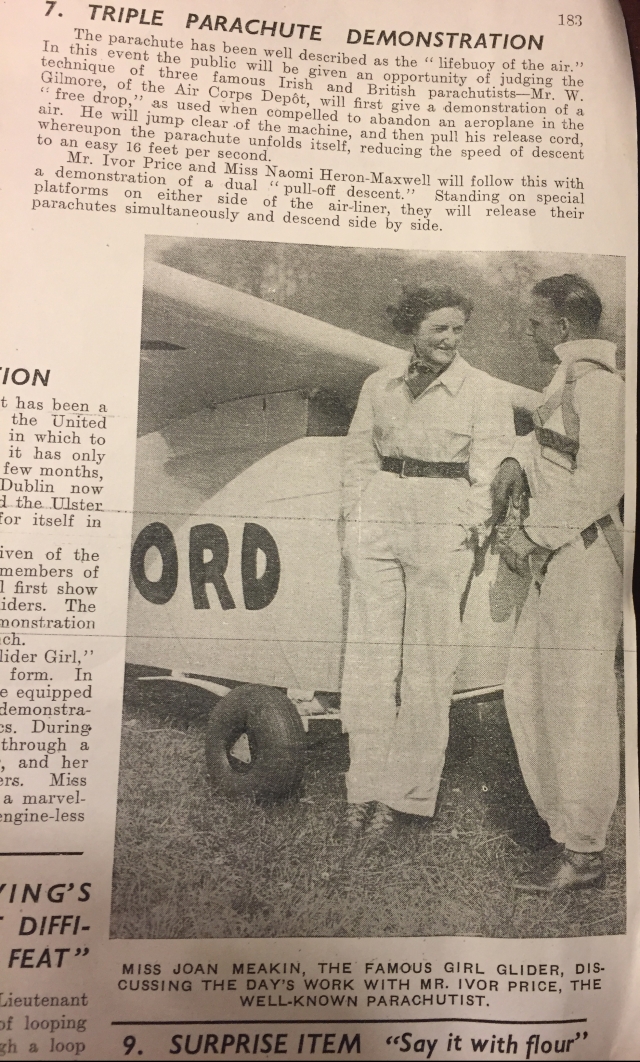
Aviation magazine, 1935.
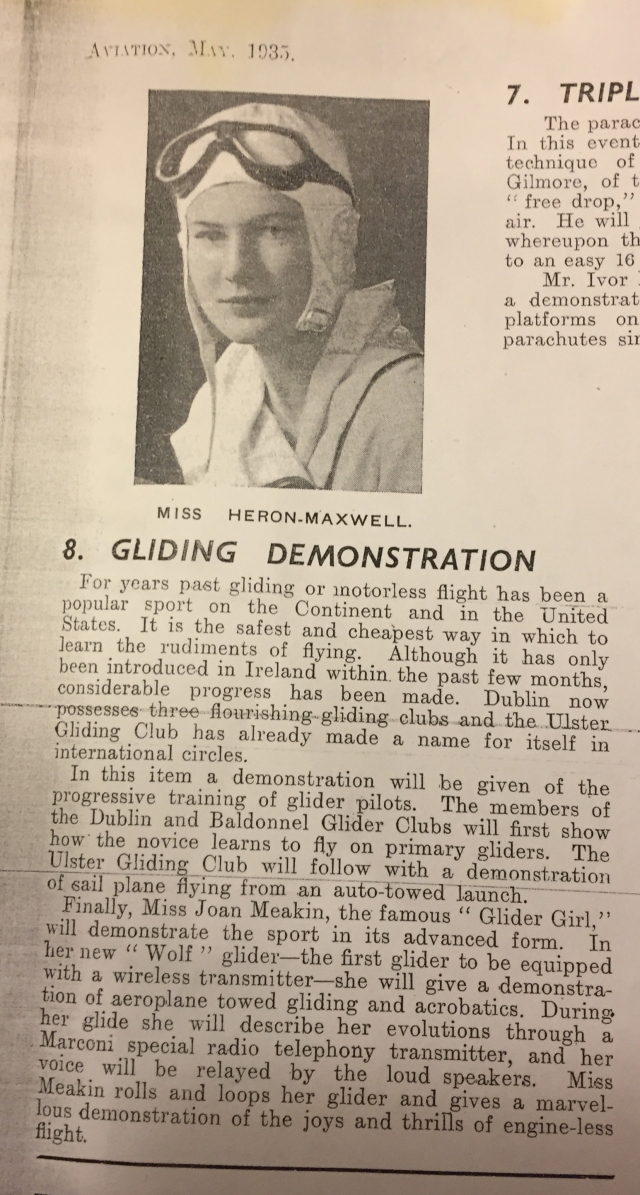
Aviation magazine, 1935.
Amelia Earhart (American) is perhaps the most iconic among the female pilots of the era. Images of her in her pilot’s costume still look surprisingly modern. Amy Johnson (English) was the first woman to fly solo to Australia in 1930; she crashed and died while in active service during the Second World War in 1941, aged 37. See newsreel footage of her here. But there were Irish women aviators too. One of them, Lady Heath (Sophie Peirce Evans, from County Limerick), is represented in a portrait by John Lavery in Dublin’s Hugh Lane Gallery (1928). The text next to the painting says she was the first person to fly a small open cock-pit plane solo from Cape Town to London. Apologies for concentrating on her looks (as though ignoring her deeds because she’s a woman!) she cuts a very impressive figure in her pilot’s flight-suit, gloves and goggles. A dash of red lipstick completes her glamorous image. She looks like she’s sitting in the aeroplane, casually leaning on one bent arm – showing off the elbow-high pilot’s gloves – a look of total confidence (or maybe that’s a ‘withering look’) on her face, with a heavily clouded sky in the background. She has no time to waste, she’s ready to lower the goggles and get on with her busy schedule!

An Irish Pilot (Lady Heath) by Sir John Lavery (1928). Hugh Lane Gallery Dublin.

Amelia Earhart looking very content.
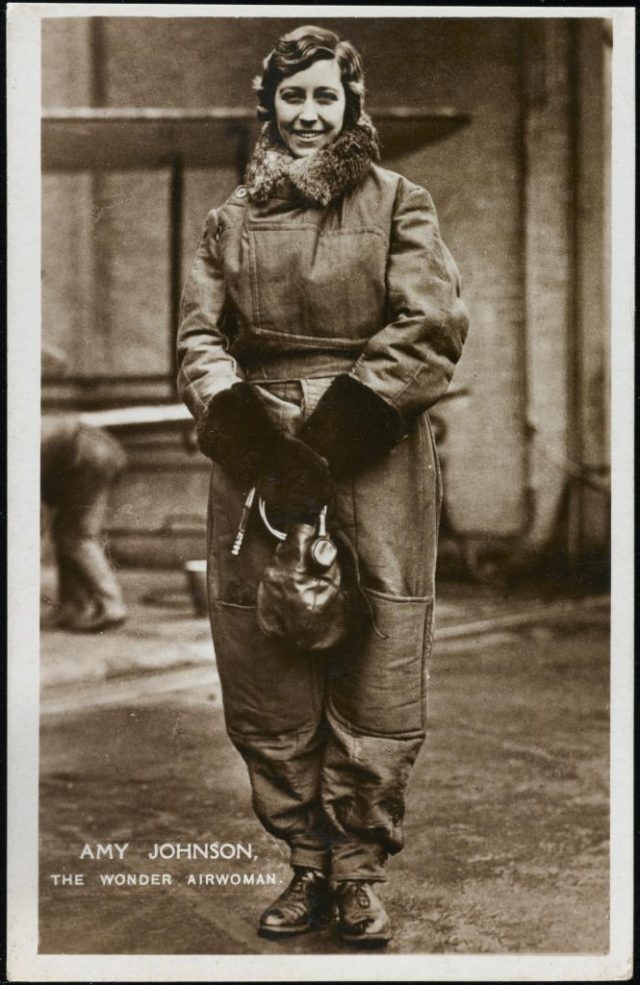
Amy Johnson ‘Queen of the Skies’ in her flight suit (https://blog.sciencemuseum.org.uk/amy-johnsons-birthday/)
Warm clothing was essential as early aeroplanes were very cold, they weren’t pressurised, and apparently there was a sickening smell of fuel. The pathe newsreel footage shows the delicate little aeroplanes wafting in on the air currents and bouncing onto the runway, almost being held down by people on the ground… It would make a good visual metaphor for the giddy uncertainty of the age.
“Missing”
In April 1937, Aviation reported that the ‘Flying Duchess’ (Mary Russell, Duchess of Bedford) was missing and that an extensive search by police and airmen was being undertaken. The search had moved from land to sea as part of a plane similar to the one she had been flying in was found on the Norfolk Coast. The magazine listed her ‘recreations apart from flying’ as natural history, fishing, shooting and radiography. She started flying at the age of 62 as she ‘regarded it as the most exhilarating of all sports’ according to the journal (other sources say she started flying at 61). Her death while flying, at age 71, is actually recorded now as March 1937, just a few months before Amelia Earhart went missing. Like Amelia Earhart, the wreckage was never found; she is believed to have gone down over the sea. See some 1930 pathe newsreel footage of the duchess here; she had just flown to Capetown and back (in record time), at the age of 64, and there she is arriving at Croydon airport looking very powerful indeed. Aviation reported that:
‘Aerial acrobatics in no way frightened her, and she delighted in an occasional “spin” or “Immelmann turn.” In Spring of last year she made a trip of 5,500 miles, flying to Paris Biarritz, Madrid, Tangiers, Toulouse, Lyon and back to London. This was her greatest and most thrilling flight.’
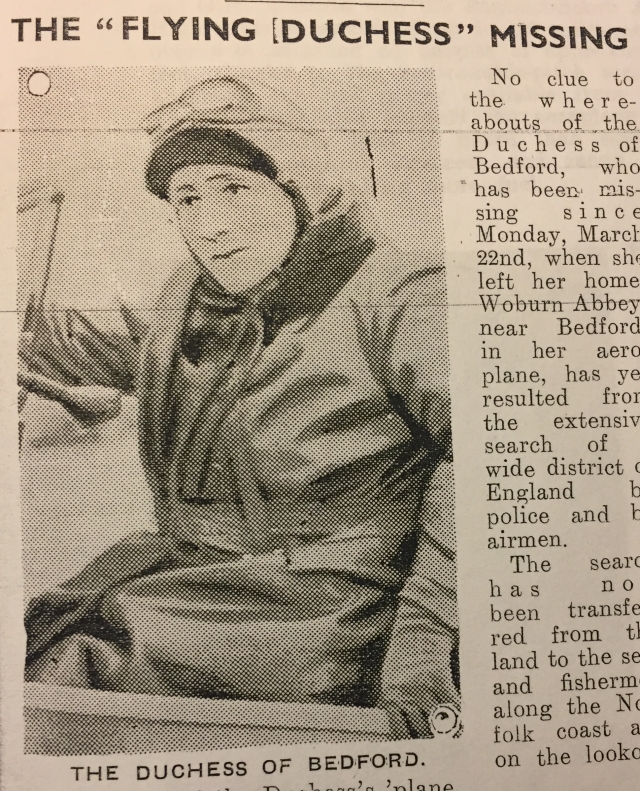
Aviation magazine, 1937.
In September 1935 Aviation reported on the ‘Feminine Aspect of Flying’. The article states that of the two thousand licensed (private) pilots in Britain, less than 100 were women and of those that:
‘There is undoubtedly a small section of these whose one ambition for various personal reasons is solely to obtain a pilot’s licence’.
I quite admire their feistiness and willingness to get involved in such a daring pursuit, even if some of them were just doing it for larks and didn’t mean to carry on. The writer speculates that: ‘Of these, about a tenth are acknowledged as worthy of consideration as pilots in the true sense’. Oh well, I thought this would be an uplifting article.
The ‘Moth’ as an alternative to the ‘Model T’?
The article notes that many pilots didn’t renew their licences because there were not enough aerodromes to make it an efficient and reliable form of transport! This ties in with the idea in the 1930s that flying would in the near future become a means of daily transport to and from the office in the city, for example. From the late 1920s there were advertisements for Vulcanite in the Irish Builder and Engineer stating that ‘Flat Roofs will be even more important in the Future’. They typically featured images of a light aircraft landing on a tall flat roofed building.
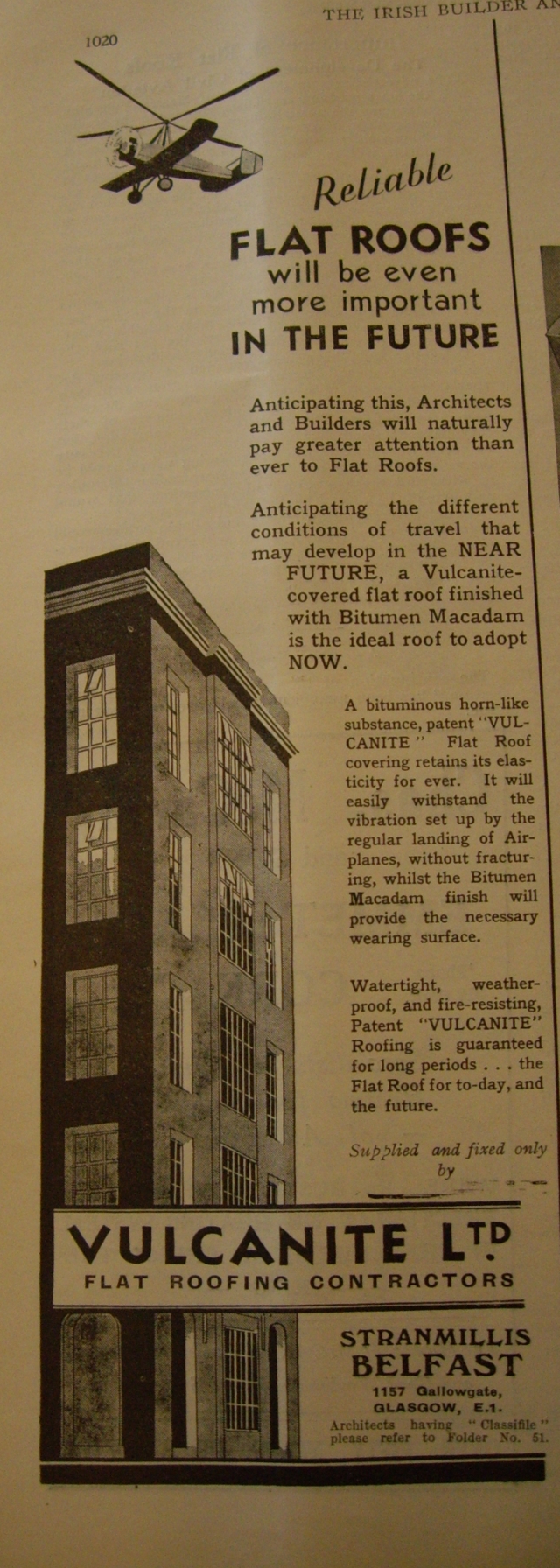
Vulcanite advertisement from the Irish Builder and Engineer, 1930s.
‘safe, convenient, speedy and economical…’
In 1928 The Irish Builder and Engineer had reported on a lecture at the Dublin Rotary Club by Lady Heath herself. It was titled ‘Light Aeroplanes’ and she described how flying was ‘now becoming a means possible for the average man or woman and that it is a safe, convenient, speedy and economical method of travel’. She stated, according to the reporter that, an ‘aeroplane or seaplane is as easy to handle as a motor car’ and that ‘Ireland has been designed by nature as a stepping stone between America and Europe’ – certainly this was the reason for Ireland embracing civil aviation, and that ‘seaplanes are more attractive to the Irish as we are used to the sea’ – there was discussion in the 1930s about whether to build an airport in Dublin for seaplanes or land /airplanes. She advised that the potential of aviation ‘should arouse professional and patriotic pride’. She concluded that ‘what women can do to help aviation men can surely surpass’ – so presumably men should have been doing more! When the Blue Lagoon project was being contemplated for Bull Island at this time (enclosing it to form a marine lake by the sea and creating a vast public playground) the Irish Builder emphasised the importance of incorporating a flying ground, for people to land their ‘busby moths’ while they go to ‘deport themselves’ at aquatic sports. The Irish Aero Club had been established in 1929.
Conclusion
There’s so much to say about aviation in this period and it would take more than a few hours on a Tuesday evening to write about this properly! I think if I was to write a book it could easily be on this topic – it’s fascinating. Other notable Irish female aviators are Eileen Gray (architect / designer) and Lilian Bland (Anglo-Irish) who designed, built and learned to fly her own aeroplane, which she called the Mayfly, in 1911-2!
Articles such as ‘War and Peace in the Machine Age’, ‘The Mystery of Speed’, ‘In the Air – To-Morrow’ and ‘Is the Biplane Doomed’ all featured in 1935. The editor greeted the new year in 1935 with some romantic lines:
‘Unto the stars and the milky way
the sky above and the earth below
seeking the light of another day
and the dawn of a future now.’
– the future was ready for the making.
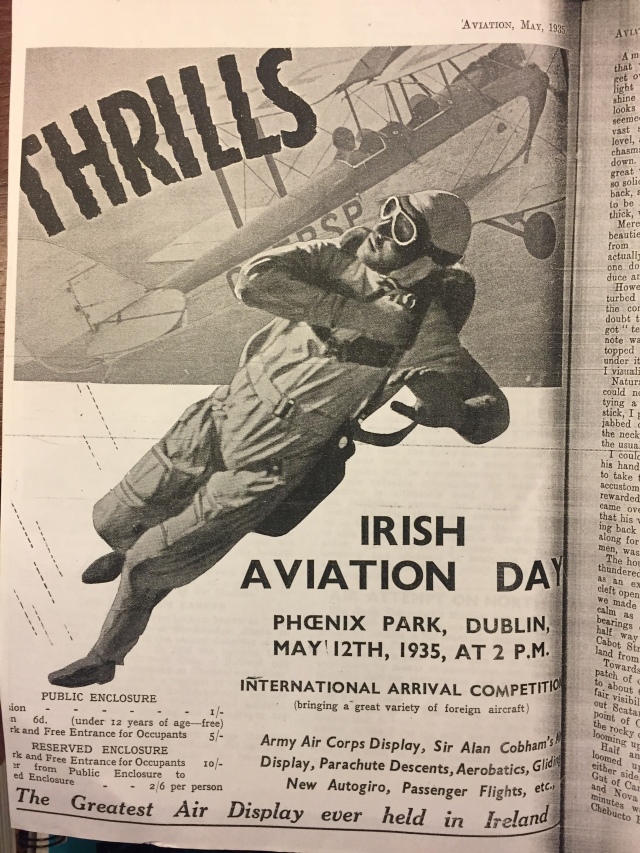
Note: Unauthorised use and or duplication of this material without express and written permission from the site’s author and or owner is strictly prohibited. Excerpts and links may be used, provided that full and clear credit is given to the author with appropriate and specific direction to the original content.




To see the journal, I assume that it is in the National Library. I saw it and made copies in the library opposite Pearse station a few years ago
JOHN KING, LONDON SE12
LikeLike
Hi John, I looked at it in Trinity College but I suppose it must be in other places too.
LikeLike